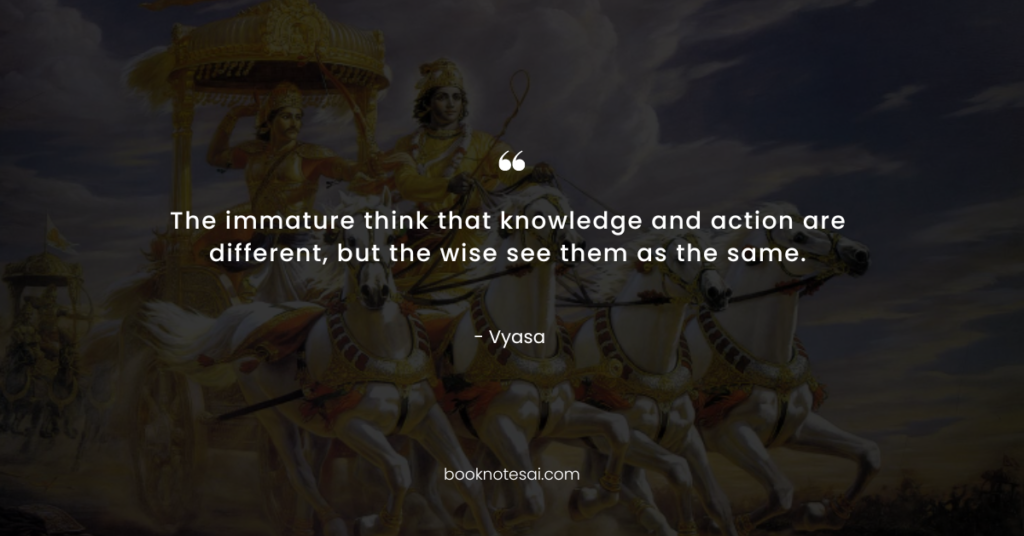Listen To This Post
The Bhagavad Gita Summary: A Spiritual Guide to Life’s Journey.
“The wise see knowledge and action as one; they see truly.”

This is a book summary for The Bhagavad Gita by Vyasa Translated by Eknath Easwaran . The essential information is structured to be practical, clear, and really helpful, while also saving you a bunch of time.
Introduction: Why this book?
- The Bhagavad Gita is a timeless scripture that offers profound insights into the nature of existence and the path to spiritual enlightenment.
- Through its teachings, readers can gain wisdom to navigate life’s challenges and find inner peace amidst turmoil.
The Bhagavad Gita Summary:
- The Bhagavad Gita, often referred to as the Gita, is a conversation between Prince Arjuna and Lord Krishna on the battlefield of Kurukshetra.
- It addresses the moral dilemmas faced by Arjuna and explores concepts such as duty, righteousness, and the nature of the self.
- The Gita emphasizes the importance of fulfilling one’s duty without attachment to the results, known as karma yoga.
- It teaches the pursuit of self-realization through devotion (bhakti yoga), knowledge (jnana yoga), and disciplined action (karma yoga).
- Ultimately, the Bhagavad Gita encourages individuals to strive for spiritual liberation and union with the divine
💡 5 Big Ideas
- Duty and Dharma: The Gita emphasizes the importance of fulfilling one’s duty and adhering to one’s dharma, regardless of the circumstances.
By doing so, individuals can find fulfillment and contribute positively to society. - Detachment from Fruits of Action: The concept of karma yoga teaches the importance of performing actions selflessly, without attachment to the outcomes.
This fosters a sense of inner peace and freedom from the anxieties of success or failure. - Pathways to Liberation: The Gita presents various paths to spiritual liberation, including devotion, knowledge, and disciplined action.
Each individual is encouraged to follow the path that resonates most with their nature and disposition. - The Nature of the Self: Through introspection and spiritual inquiry, the Gita explores the nature of the self (atman) and its eternal connection to the divine (Brahman). Recognizing this inherent divinity leads to self-realization and inner harmony.
- Unity in Diversity: Despite the diversity of paths and beliefs, the Bhagavad Gita emphasizes the underlying unity of all existence.
It teaches tolerance, respect, and understanding towards all beings, fostering a sense of universal brotherhood.
In summary, the Bhagavad Gita offers profound insights into life’s purpose, the nature of reality, and the path to spiritual fulfillment.
It teaches us to embrace our duty, cultivate detachment, pursue self-realization, and recognize the unity of all creation.
Powerful Quotes
- “You have the right to perform your prescribed duties, but you are not entitled to the fruits of your actions.”
This quote emphasizes the importance of detached action and selflessness. - “The mind is restless and difficult to restrain, but it is subdued by practice.”
This quote highlights the challenge of controlling the mind through discipline and practice. - “The wise see knowledge and action as one; they see truly.”
This quote underscores the integration of knowledge and action in the pursuit of enlightenment. - “When meditation is mastered, the mind is unwavering like the flame of a lamp in a windless place.”
This quote illustrates the stability and clarity attained through mastery of meditation. - “For one who has conquered the mind, the mind is the best of friends; but for one who has failed to do so, the mind is the greatest enemy.”
This quote emphasizes the importance of mastering the mind to achieve inner peace. - “One who sees inaction in action, and action in inaction, is intelligent among men.”
This quote challenges conventional notions of action and inaction, urging a deeper understanding of karma. - “The soul can never be cut to pieces by any weapon, nor burned by fire, nor moistened by water, nor withered by the wind.”
This quote speaks to the eternal nature of the soul, beyond the limitations of the physical body. - “The immature think that knowledge and action are different, but the wise see them as the same.”
This quote highlights the synthesis of knowledge and action on the path to wisdom. - “A man’s own self is his friend, a man’s own self is his foe.”
This quote reflects the internal struggle faced by individuals in their quest for self-mastery. - “Set thy heart upon thy work, but never on its reward.”
This quote underscores the importance of focusing on the process rather than the outcome in the pursuit of excellence.
One Reason To Read This Book:
The Bhagavad Gita offers timeless wisdom and practical guidance for navigating life’s challenges with clarity, purpose, and inner peace.
Who should I recommend The Bhagavad Gita Summary to?
Anyone seeking spiritual guidance, philosophical insights, or practical wisdom for leading a fulfilling life would benefit from exploring the teachings of the Bhagavad Gita.
Recommendations:
- “The Upanishads” – Explore the philosophical foundations of Hinduism through the ancient scriptures known as the Upanishads.
- “The Yoga Sutras of Patanjali” – Delve into the principles and practices of yoga as elucidated by the sage Patanjali.
- “The Dhammapada” – Discover the timeless teachings of Buddha encapsulated in this collection of verses on ethics, mindfulness, and enlightenment.
This summary serves as a complimentary guide to the reviewed title The Bhagavad Gita, offering key insights. For a deeper understanding, we encourage you to explore the full book.


